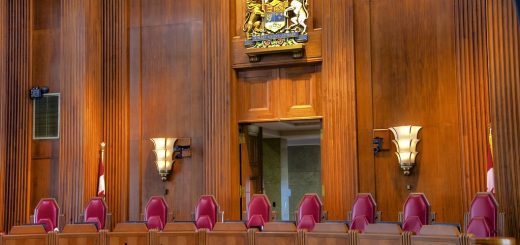Minority Language Education for Majority Students: CS Francophone du Yukon v Yukon Territory
On 26 June 2014, the Supreme Court of Canada (“SCC”) agreed to hear an appeal of Commission Scolaire Francophone du Yukon v Attorney General of the Yukon Territory, 2014 YKCA 4 [CS Francophone]. The case concerns a dispute over the control and management of the Territory’s French language education system and is the first time in over a decade that the SCC will render a decision on the scope of minority language education rights in English Canada.
The issue in the appeal is whether sections 2, 5, and 9 of the French Language Instruction Regulation, YOIC 1996/099, infringes section 23 of the Charter by limiting admission to minority language school boards to students whose parents are members of the linguistic minority community.
Section 23 of the Charter
Section 23 of the Charter provides three well-defined routes to establish status as a rights holder:
(1) Citizens of Canada
(a) whose first language learned and still understood is that of the English or French linguistic minority population of the province in which they reside, or
(b) who have received primary school instruction in Canada in English or French and reside in a province where the language in which they received that instruction is the language of the English or French linguistic minority population of the province,
have the right to have their children receive primary and secondary school instruction in that language in that province
(2) Citizens of Canada of whom any child has received or is receiving primary or secondary school instruction in English or French in Canada, have the right to have all their children receive primary or secondary school instruction in the same language.
For those unacquainted with minority language education rights jurisprudence it may seem odd that a French language community would assert a right to dilute their linguistic and cultural minority by including members of the majority language community. This position can be explained by the SCC decisions in Mahe v Alberta, [1990] 1 SCR 342 [Mahe], Arsenault-Cameron v Prince Edward Island, [2000] 1 SCR 3 [Arsenault-Cameron], and Doucet-Boudreau v Nova Scotia, [2003] 3 SCR 3 [Doucet-Boudreau], which provide an adverse incentive for French language school boards to inflate the number of Anglophone students enrolled at their facilities.
In Mahe, the SCC determined that the right to management and control of minority language schools is on a sliding scale, depending on the number of children of rights holders in the area. Numbers at the bottom end of the scale may only require instruction services while numbers at the top end will require facilities managed and controlled by the minority.
The number of children of rights holders used to determine a community’s position on the sliding scale in an estimate of the amount of rights-holders who will potentially take advantage of the minority language education services. According to Arsenault-Cameron, this number will be somewhere between the current proven demand and the total number of students eligible to use the service under section 23 of the Charter.
Once the section 23 right to facilities is established, Doucet-Boudreau held that these facilities must be provided without delay. This flows from the unique nature of minority language education rights, which can disappear due to government inaction.
Based on the approach mandated by these decisions, education facilities for French language rights holders are often built with a maximum capacity much higher than the number of registered pupils. This is done to ensure there is adequate space for all those eligible to exercise section 23 rights. Yet, if the children of rights holders do not materialize, minority language school officials may take on majority language students to ensure the facility remains viable. This is the situation in CS Francophone.
L’École Émilie-Tremblay
In 1996, the Commission Scolaire Francophone du Yukon (“CSFY”) was established and the children of section 23 Charter rights holders moved into l’École Émilie-Tremblay (“EET”). The building had a maximum capacity of 289 students, and 113 students had enrolled. When the trial commenced during the 2010–2011 school year, 162 students at EET were children of rights holders – 141 on the basis of section 23(1)(a), 12 on the basis of section 23(1)(b), and 9 on the basis of section 23(2). Twenty-five students were not the children of rights holders.
Enrolment data showed a steady growth in the number of children of non-rights holders admitted to EET. In 2005–2006 the percentage was 5%. By 2010–2011 it was 13%.
Supreme Court of Yukon
The trial judge found that the CSFY had the right to admit the children of non-rights holders to EET. His reasons were brief and focused on the school board’s right to control and management of its facility. He cited Arsenault-Cameron, “Where a minority language board has been established in furtherance of s. 23, it is up to the board, as it represents the minority official language community, to decide what is more appropriate from a cultural and linguistic perspective” (at para 43). Therefore, when the territorial government developed the institutional structure of its minority language services through the French Language Instruction Regulation, it was limited by the specific needs of the minority language community.
In making his decision the trial judge acknowledged that no Canadian court had yet suggested that minority-language school boards had complete autonomy in determining who should be admitted to their schools.
Court of Appeal for Yukon
The Court of Appeal for Yukon (“YKCA”) rejected the trial judge’s reasoning. In making its decision the court relied on the SCC’s “modern approach to interpreting the Charter’s language provision” (at para 220) in R v Beaulac, [1999] 1 SCR 768:
Language rights must in all cases be interpreted purposively, in a manner consistent with the preservation and development of official language communities in Canada… To the extent that Société des Acadiens du Nouveau-Brunswick… stands for a restrictive interpretation of language rights it is to be rejected. The fear that a liberal interpretation of language rights will make provinces less willing to become involved in the geographical extension of those rights is inconsistent with the requirement that language rights be interpreted as a fundamental tool for the preservation and protection of official language communities where they do apply (at para 25).
According to the YKCA, a purposive approach does not support Anglophone use of EET. Section 23 is not designed to ensure that those who belong to the linguistic majority are encouraged to learn the minority language. Rather, it is concerned with the right of the children of the linguistic minority to be educated in their own language.
Conclusion
It seems difficult to argue with the YKCA’s rationale. In Mahe, the SCC’s discussion of control and management by minority linguistic communities was based on protecting the minority culture from assimilation. The CSFY’s desire to instruct children from the majority community at EET seems to directly contradict this goal. One can easily imagine that Anglophone students, speaking English in school hallways and at recess, could put a significant strain on the Yukon’s fragile Francophone community.







Join the conversation